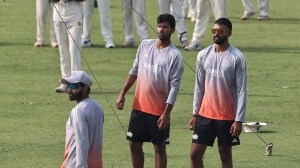From Chakwara to Jhajjar
Atrocities on Dalits are not a new phenomenon, despite the silence of historical records. They can be divided into two broad categories: one...

Atrocities on Dalits are not a new phenomenon, despite the silence of historical records. They can be divided into two broad categories: one, the ‘traditional’ crimes involving the denial of any right whatsoever; and, two, those that emanate from the caste Hindu backlash against modern forms of Dalit resistance.
The killing of five Dalits near Jhajjar, in Haryana on October 16, falls in the first category. The mob here showed no mercy because of a perception that Dalits are to be treated worse than animals. After the incident, instead of ordering an inquiry into it, the authorities ordered the post-mortem of the cow instead — as if the life of a cow was more precious than that of five human beings. This is the insensitivity with which Dalit atrocities are approached. The second incidence — which occurred at Chakwara near Jaipur when Dalits were denied access to the water tank and temple on September 22 lest they defile both — belongs to the second category.
While the atrocities of the second kind are becoming increasingly prevalent, it is disturbing to note that the total number of cases of atrocities on the Dalits has been multiplying by the day precisely because the traditional kind of atrocities have not withered away.
These crimes must be seen in the present socio-political context, in which two processes are going on apace in contemporary India: globalisation, with its information revolution and privatisation, and the saffronisation of society, which includes Dalits.
As far as globalisation is concerned, it is often argued that with the onset of this process the social relations based on primordial loyalties and hierarchies would be replaced by global identities. But the irony is that this has never happened in India nor is it likely to happen in a hurry. In fact, caste Hindus have continued to interact with Dalits on the same primordial terms as they have always done.
The atrocity data of the Sixth Report of Commissioner of Scheduled Caste and Scheduled Tribes- 1999-2000 & 2000-2001 proves this point. The report reveals 23,742 atrocity cases against the Dalits in the year 2000 alone. Out of 23,742 cases, there were 1,034 rape cases of Dalit women and 3,241 murder of Dalits: this means approximately three cases of rape and nine murders per day. One must bear in mind when confronted with such figures, that these are only the reported cases. A substantial number go unreported.
Coming to the aspect of the saffronisation of Dalits, well, the issue is a bit more complicated than is generally perceived. After the Gujarat carnage and the formation of the BSP-BJP coalition government in Uttar Pradesh, it was widely perceived that a process of saffronisation of Dalits was taking place in contemporary India. To prove this, political and social analysts took stray incidents that had occurred during the Gujarat riots, where Dalits were seen to be playing a part in the communal frenzy.
But no quick conclusions can be drawn from this. After all, there is a contradiction in the fact that while Dalits are getting ‘Hinduised’, and aligning with the Sangh Parivar in one part of the country, in another they are being denied access even to tanks and temples, as Chakwara demonstrated, or brutally felled down, as in Jhajjar. It would, therefore, be premature to jump to the conclusion that Dalits are getting Hinduised.
In fact, one can equate the social status of Dalits with that of Muslims. Both are affected by the dominance of the caste Hindu psyche in the country’s social and political life. To maintain their hegemony they play down internal differences and highlight a homogenised Hindu whole. But this is a myth that is being employed to intimidate the minorities. The irony is both Dalits and Muslims do not understand that one is being used against other and both, ultimately, are victims of the caste Hindu social order.
This conclusion is inescapable, given the fact that despite constitutional safeguards, legislation, modernisation, industrialisation and even globalisation, atrocities against Dalits go on unabated.
(The writer is assistant professor, Centre for the Study of Social Systems, JNU)
Photos



- 01
- 02
- 03
- 04
- 05




























